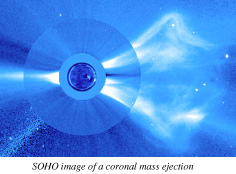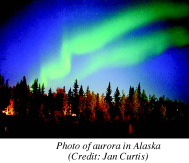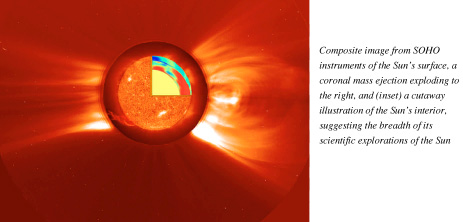 What? The ISTP program is a comprehensive effort to observe and
understand our star and its effects on our environment. An armada of space- and ground-based observatories probe the Sun, the Earth, and thespace between them from many angles and in many different ways...mostof them invisible to the human eye. What? The ISTP program is a comprehensive effort to observe and
understand our star and its effects on our environment. An armada of space- and ground-based observatories probe the Sun, the Earth, and thespace between them from many angles and in many different ways...mostof them invisible to the human eye.
 Who?ISTP includes spacecraft launched by
NASA and the European Space Agency, Russia's
Space Research Institute, and Japan's Institute for
Space & Astronautical Science. Other spacecraft and
significant computer and radar facilities are also
provided by: Max Planck Institute, National Oceanic
& Atmospheric Administration, Los Alamos National
Laboratory, the U.S.Air Force, Canadian Space
Agency, British Antarctic Survey, U.S. National
Science Foundation, and Johns Hopkins Applied Physics Laboratory. The four principal spacecraft
are Polar, Geotail, Wind, and the Solar and Heliospheric Observatory (SOHO). Who?ISTP includes spacecraft launched by
NASA and the European Space Agency, Russia's
Space Research Institute, and Japan's Institute for
Space & Astronautical Science. Other spacecraft and
significant computer and radar facilities are also
provided by: Max Planck Institute, National Oceanic
& Atmospheric Administration, Los Alamos National
Laboratory, the U.S.Air Force, Canadian Space
Agency, British Antarctic Survey, U.S. National
Science Foundation, and Johns Hopkins Applied Physics Laboratory. The four principal spacecraft
are Polar, Geotail, Wind, and the Solar and Heliospheric Observatory (SOHO).
 Why?Events on the Sun can trigger changes in Earth's environment, particularly in the regions of the atmosphere known as the ionosphere and the magnetosphere. Like the wind here on Earth, the solar wind blows soft and hard, sometimes leading to magnetic storms in the atmosphere. Such storms can interfere with radio, television, and telephone signals, upset the navigation systems of ships and airplanes, and cause blackouts. Also, sun-induced storms can damage satellites and spacecraft or force them to re-enter the atmosphere prematurely. By closely observing the Sun and the energy and materialit blows at Earth, scientists may someday be able to anticipate changes in Earth's environment. Aside from disturbing our electronic tools and toys, the Sun and its wind‹the solar wind‹seem to play a role in long-term climate changes on Earth. And finally, since our solar system is probably typical of other single-star systems in the universe, what scientists learn about the Sun-Earth connection could lead to a better understanding of other solar systems. Why?Events on the Sun can trigger changes in Earth's environment, particularly in the regions of the atmosphere known as the ionosphere and the magnetosphere. Like the wind here on Earth, the solar wind blows soft and hard, sometimes leading to magnetic storms in the atmosphere. Such storms can interfere with radio, television, and telephone signals, upset the navigation systems of ships and airplanes, and cause blackouts. Also, sun-induced storms can damage satellites and spacecraft or force them to re-enter the atmosphere prematurely. By closely observing the Sun and the energy and materialit blows at Earth, scientists may someday be able to anticipate changes in Earth's environment. Aside from disturbing our electronic tools and toys, the Sun and its wind‹the solar wind‹seem to play a role in long-term climate changes on Earth. And finally, since our solar system is probably typical of other single-star systems in the universe, what scientists learn about the Sun-Earth connection could lead to a better understanding of other solar systems.
 When? ISTP was conceived in the 1970s, planned in the 1980s, and launched in the 1990s. The first spacecraft, Geotail, was launched in 1992, and the most recent, Polar, went up in 1996. Each of the missions of ISTP is scheduled to continue through 2001. When? ISTP was conceived in the 1970s, planned in the 1980s, and launched in the 1990s. The first spacecraft, Geotail, was launched in 1992, and the most recent, Polar, went up in 1996. Each of the missions of ISTP is scheduled to continue through 2001.

How? The spacecraft of ISTP are placed in orbits that allow physicists to observe the key regions of Earth's space, or "geospace." Those regions include the Sun's surface and atmosphere, the solar wind, and Earth's magnetosphere, from the bow shock to the auroral regions to the magnetic tail. Orbiting as far as one million miles from Earth and as close as a few hundred, the spacecraft of ISTP make coordinated, simultaneous observations of the Sun and geospace over extended periods of time. With such observations, scientists are increasing our knowledge of: the structure and dynamics of the Sun; the origin of the solar wind; the composition and character of the solar wind; the flow of energy between Sun and Earth, and the cause-effect relationship between events on the Sun and their impact on Earth.
To download a PDF version of Profile of a Sun-Earth Obervatory: ISTP click here.
|
 What? The ISTP program is a comprehensive effort to observe and
understand our star and its effects on our environment. An armada of space- and ground-based observatories probe the Sun, the Earth, and thespace between them from many angles and in many different ways...mostof them invisible to the human eye.
What? The ISTP program is a comprehensive effort to observe and
understand our star and its effects on our environment. An armada of space- and ground-based observatories probe the Sun, the Earth, and thespace between them from many angles and in many different ways...mostof them invisible to the human eye.
 Who?ISTP includes spacecraft launched by
NASA and the European Space Agency, Russia's
Space Research Institute, and Japan's Institute for
Space & Astronautical Science. Other spacecraft and
significant computer and radar facilities are also
provided by: Max Planck Institute, National Oceanic
& Atmospheric Administration, Los Alamos National
Laboratory, the U.S.Air Force, Canadian Space
Agency, British Antarctic Survey, U.S. National
Science Foundation, and Johns Hopkins Applied Physics Laboratory. The four principal spacecraft
are Polar, Geotail, Wind, and the Solar and Heliospheric Observatory (SOHO).
Who?ISTP includes spacecraft launched by
NASA and the European Space Agency, Russia's
Space Research Institute, and Japan's Institute for
Space & Astronautical Science. Other spacecraft and
significant computer and radar facilities are also
provided by: Max Planck Institute, National Oceanic
& Atmospheric Administration, Los Alamos National
Laboratory, the U.S.Air Force, Canadian Space
Agency, British Antarctic Survey, U.S. National
Science Foundation, and Johns Hopkins Applied Physics Laboratory. The four principal spacecraft
are Polar, Geotail, Wind, and the Solar and Heliospheric Observatory (SOHO).
 Why?Events on the Sun can trigger changes in Earth's environment, particularly in the regions of the atmosphere known as the ionosphere and the magnetosphere. Like the wind here on Earth, the solar wind blows soft and hard, sometimes leading to magnetic storms in the atmosphere. Such storms can interfere with radio, television, and telephone signals, upset the navigation systems of ships and airplanes, and cause blackouts. Also, sun-induced storms can damage satellites and spacecraft or force them to re-enter the atmosphere prematurely. By closely observing the Sun and the energy and materialit blows at Earth, scientists may someday be able to anticipate changes in Earth's environment. Aside from disturbing our electronic tools and toys, the Sun and its wind‹the solar wind‹seem to play a role in long-term climate changes on Earth. And finally, since our solar system is probably typical of other single-star systems in the universe, what scientists learn about the Sun-Earth connection could lead to a better understanding of other solar systems.
Why?Events on the Sun can trigger changes in Earth's environment, particularly in the regions of the atmosphere known as the ionosphere and the magnetosphere. Like the wind here on Earth, the solar wind blows soft and hard, sometimes leading to magnetic storms in the atmosphere. Such storms can interfere with radio, television, and telephone signals, upset the navigation systems of ships and airplanes, and cause blackouts. Also, sun-induced storms can damage satellites and spacecraft or force them to re-enter the atmosphere prematurely. By closely observing the Sun and the energy and materialit blows at Earth, scientists may someday be able to anticipate changes in Earth's environment. Aside from disturbing our electronic tools and toys, the Sun and its wind‹the solar wind‹seem to play a role in long-term climate changes on Earth. And finally, since our solar system is probably typical of other single-star systems in the universe, what scientists learn about the Sun-Earth connection could lead to a better understanding of other solar systems.
 When? ISTP was conceived in the 1970s, planned in the 1980s, and launched in the 1990s. The first spacecraft, Geotail, was launched in 1992, and the most recent, Polar, went up in 1996. Each of the missions of ISTP is scheduled to continue through 2001.
When? ISTP was conceived in the 1970s, planned in the 1980s, and launched in the 1990s. The first spacecraft, Geotail, was launched in 1992, and the most recent, Polar, went up in 1996. Each of the missions of ISTP is scheduled to continue through 2001.


